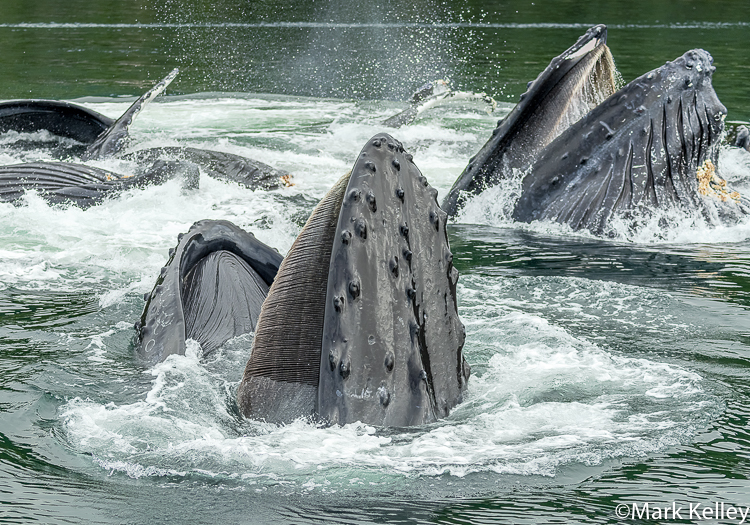Bubble-net feeding is a cooperative humpback whale behavior occurring mostly in Southeast Alaska waters. Humpbacks work together to locate and encircle schools of small bait fish, like herring, while blowing bubbles. The fish are corralled into a tight group while the whales’ vocalization frightens the fish to flee toward the surface. With mouths wide open the whales swim up and through the “net” to gulp down the fish. This photo helps to explain humpback whale biology, and here is my quick Humpback Whale Taxonomy 101: Humpbacks use their baleen plates to strain small fish out of their mouths full of water. The upper jaw contains up to 400 baleen plates that are up to two and half feet long. The whale in the center is displaying its baleen and black tongue. Humpbacks are marine mammals and the bumps on the head and along the pectoral fins are in fact hair follicles. Called “tubercles,” these fist-sized bumps contain one hair follicle each and are connected to a set of sensitive nerves. Humpbacks have somewhere between 14-35 grooves, know as ventral pleats, that extend from the chin to the navel. The ventral pleats, visible on the whale in the upper right corner, allow the throat to expand massively as sea water rushes in during feeding. This photo illustrates the month of June in my 2021Juneau Calendar. Both the 2021 Juneau and Alaska Calendars can be ordered on at markkelley.com or purchased locally at Hearthside Books, Juneau Artist Gallery, Ben Franklin, Super Bear IGA and Foodland IGA. Thank you for visiting and be well – Camera: #Nikon #D850, Lens: # Nikkor 80-400mm, Digital Capture, Handheld ©Mark Kelley
Humpback Whales, Admiralty Island, Alaska #3370

“As a kid in Buffalo, New York, I always wondered what it would be like to encounter a whale,” says Mark Kelley. Learn more about Mark…
